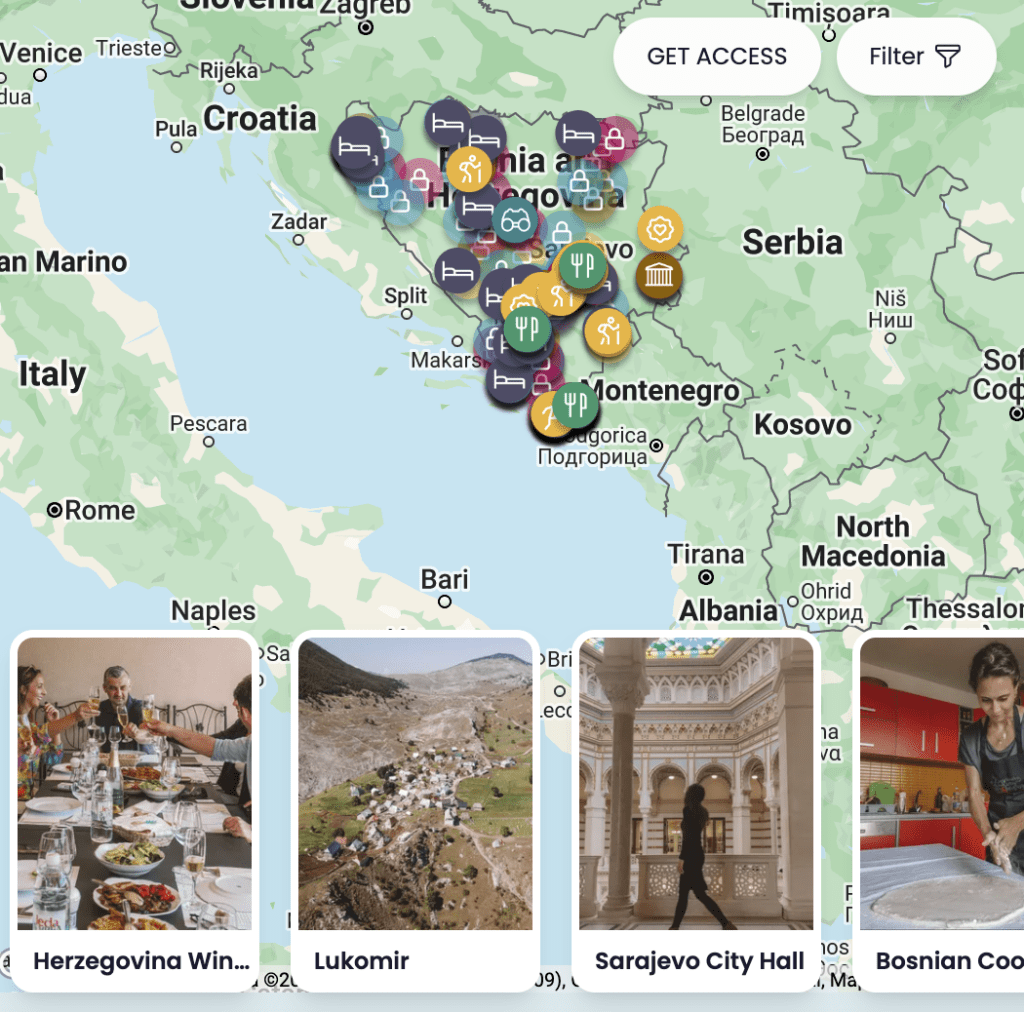Wer einmal vom Wasser in Sarajevo, der Hauptstadt Bosnien und Herzegowinas getrunken hat, der kommt immer zurück – das zumindest besagt die Legende. Und etwas Wahres ist dran: Denn wer die Stadt einmal besucht hat, den lässt sie nicht mehr los, mit ihrer Mischung aus Orient und Okzident, mit ihrer seltsam vertrauten Exotik und dem Duft nach frischem Brot und gegrilltem Fleisch, das ständig durch die Gassen zieht.
Doch nicht nur historisch ist Sarajevo ganz besonders, die Stadt zeichnet sich auch durch eine lebendige Kulturszene und zahlreiche Events .
In diesem Beitrag stelle ich dir kurz und knackig die wichtigsten Sarajevo Sehenswürdigkeiten vor und verrate dir ein paar Geheimtipps für deinen Städtetrip.
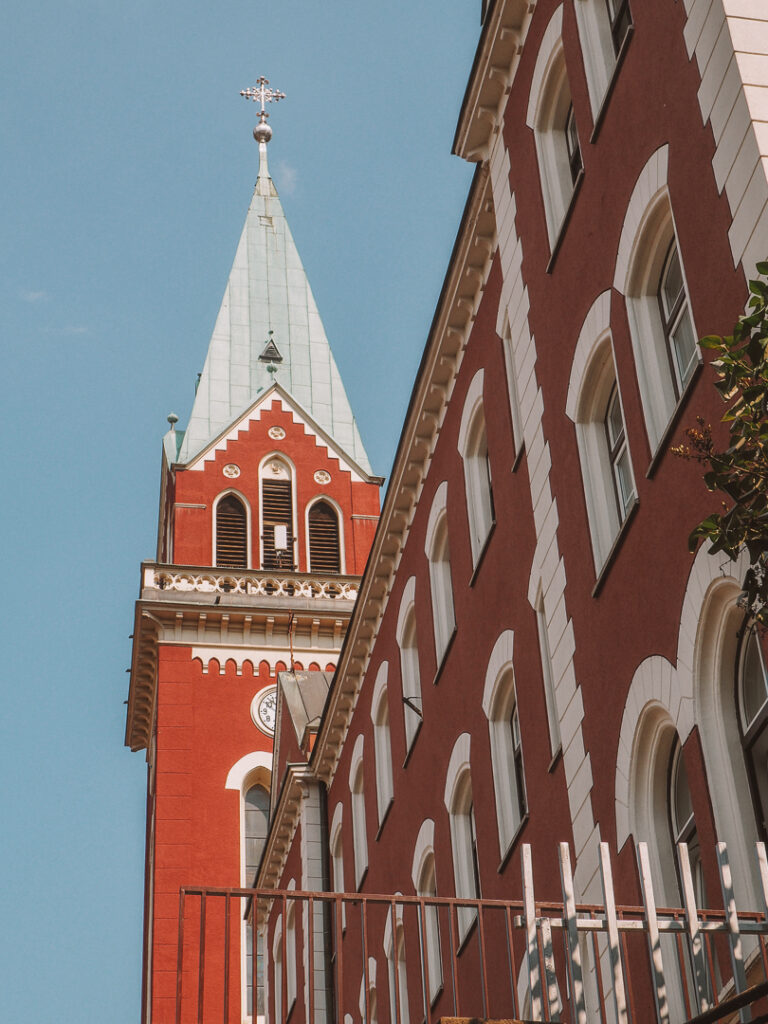
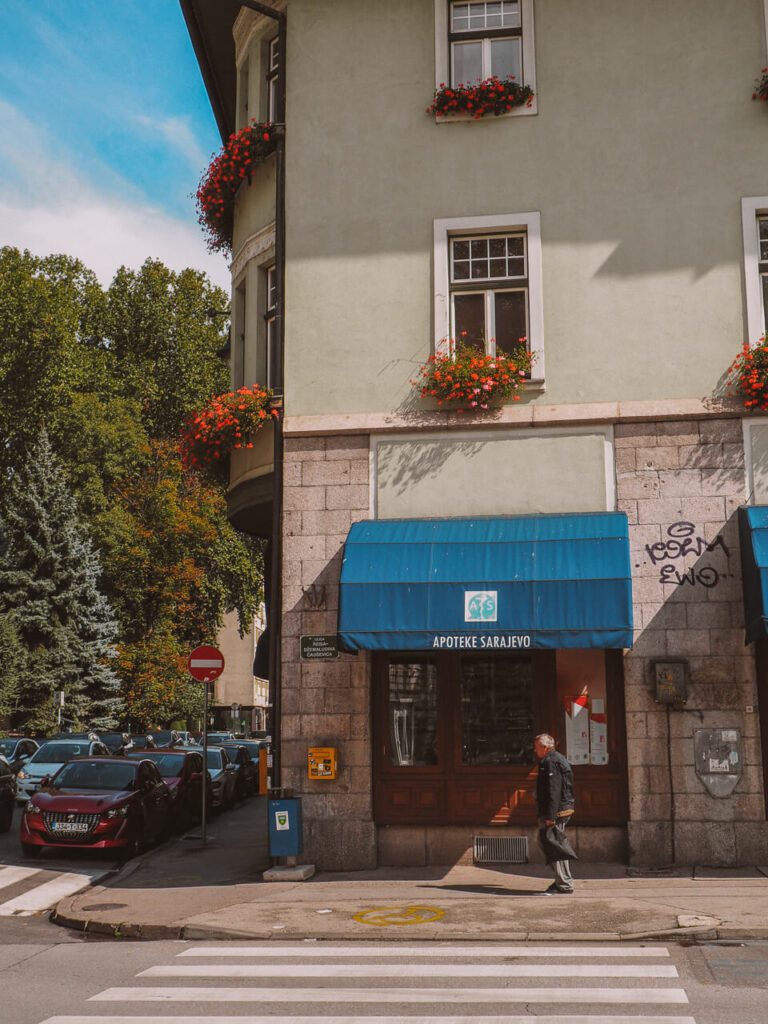
Jump directly to ↓
Sarajevo: Wissenswertes für deine Reise
Sarajevo ist zwar die größte Stadt Bosnien und Herzegowinas, zählt jedoch nur etwa 300.000 Einwohner. Entlang des Flusses Miljacka erstreckt sie sich in einem Tal auf rund 550 Höhenmetern. Einige Stadtteile strecken sich sogar bis auf 900 Meter. Im Jahr 1462 wurde Sarajevo von den Osmanen gegründet und hat seitdem viele spannende Epochen durchlaufen.
Ist Bosnien und Herzegowina in der EU?
Bosnien und Herzegowina ist nicht in der EU. Die Einreise für deutsche Staatsbürger ist aber ganz einfach mit Reisepass oder Personalausweis und ohne Visum möglich. Mehr Informationen findest du beim Auswärtigen Amt.
Anreise und Ankunft: Vom Flughafen in die Stadt
Der Flughafen von Sarajevo liegt etwa 25 Minuten mit dem Taxi vom Stadtzentrum entfernt. Du kannst also entweder direkt am Flughafen ein Taxi nehmen oder aber mit dem Bus bis in die Altstadt fahren. Hier findest du den aktuellen Fahrplan.
Sarajevo: Wie viele Tage sollte ich einplanen?
Um die wichtigsten Sarajevo Sehenswürdigkeiten zu besichtigen, ohne zu hetzen und vielleicht auch noch einen Tagesausflug zu unternehmen, würde ich für die bosnische Hauptstadt 3 bis 4 Tage einplanen. Weniger als ein langes Wochenende solltest du nicht einplanen, denn es gibt wirklich viel zu sehen uns sicherlich willst du ja auch einfach Zeit haben, dazusitzen und die Atmosphäre der Stadt aufzusaugen.
Top Sehenswürdigkeiten von Sarajevo im Überblick
No time to read the whole article?
Here are my Top-Tipps für die besten Sehenswürdikeiten in Sarajevo:
🏛️ Spaziere durch die osmanische Altstadt Baščaršija – am besten mit einer geführten Tour
🛎️ Besuche die Lateinerbrücke, wo Weltgeschichte geschrieben wurde
⭐️ Besichtige das War Childhood Museum
🌅 Schau dir den Sonnenuntergang von der Gelben Festung an
🪦 Geheimtipp: Besichtige den alten, jüdischen Friedhof
🚎 Mache eine Tour mit der ältesten elektrischen Straßenbahn Europas
🌿 Verlasse die Stadt und genieße die Natur bei Vrelo Bosne, der Quelle des Flusses Bosna
💁♀️ Unternimm einen Tagesausflug ins Naturgebiet Skakavac mit dem gleichnamigen Wasserfall
Historische Sehenswürdigkeiten & Orte
Altstadt (Baščaršija)
Der alte Basar von Sarajevo war zur osmanischen Zeit das kulturelle Zentrum der Stadt und ist auch heute noch der historische Stadtkern. Gebaut wurde er im 15. Jahrhundert. Baščaršija zieht mit Abstand die meisten Touristen in an. Kein Wunder: Einige der wichtigsten Sarajevo Sehenswürdigkeiten befinden sich hier, wie die Gazi-Husrev-beg Moschee oder Seblij. Nicht verpassen solltest du bei einer Tour durch die Altstadt die Kupferschmiedstraße Kazandziluk, in der Kupferschmiede auch heute noch arbeiten wie vor Jahrhunderten
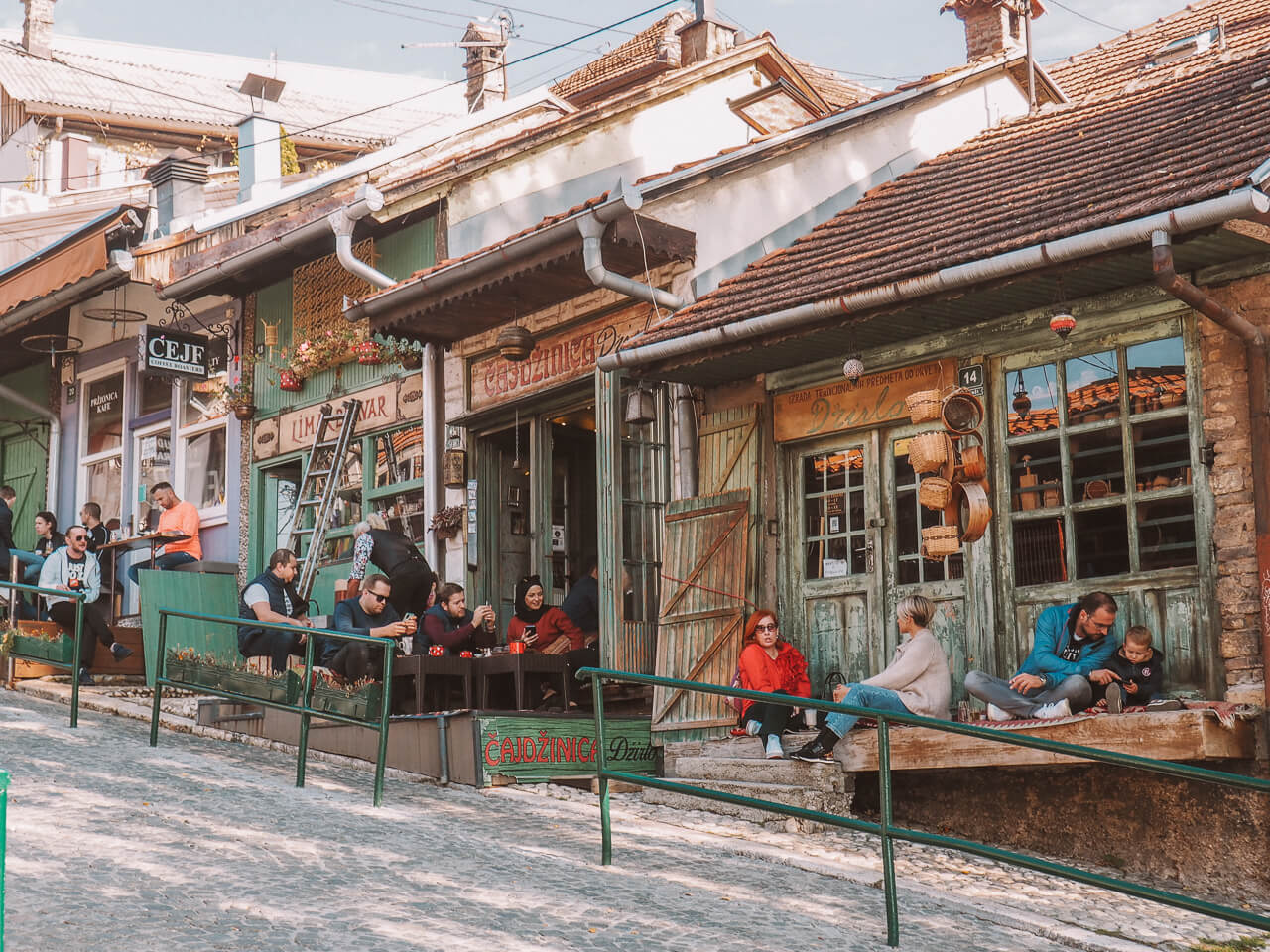
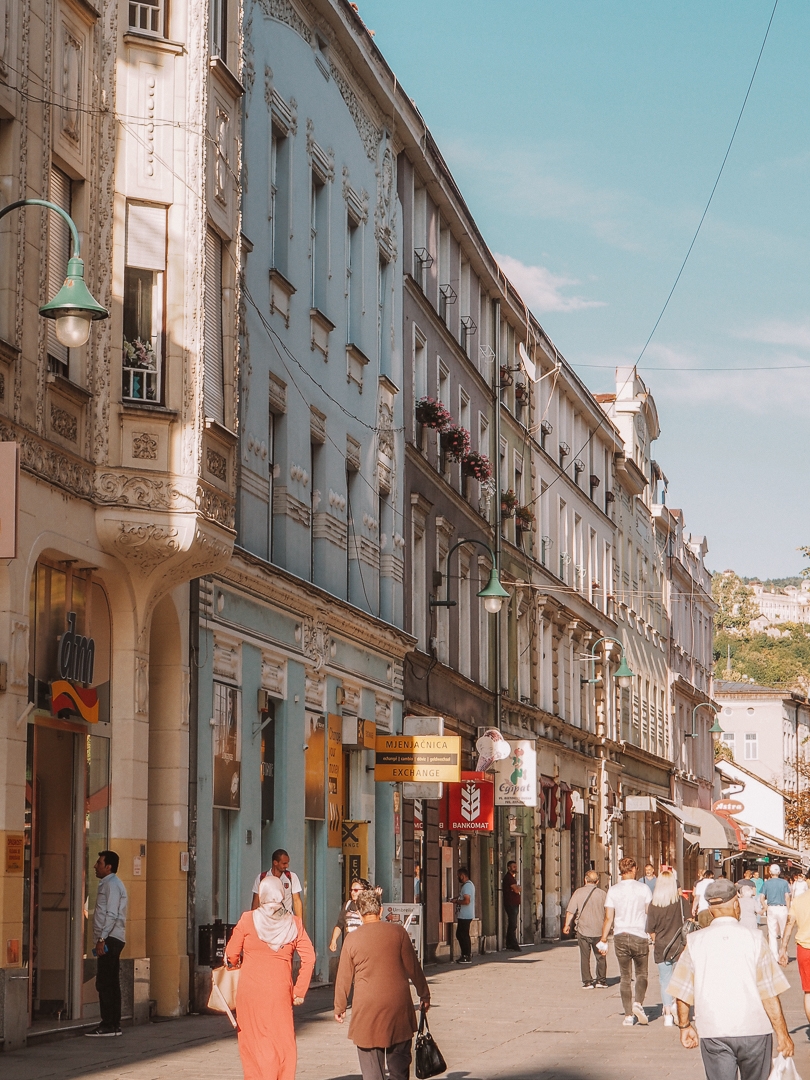
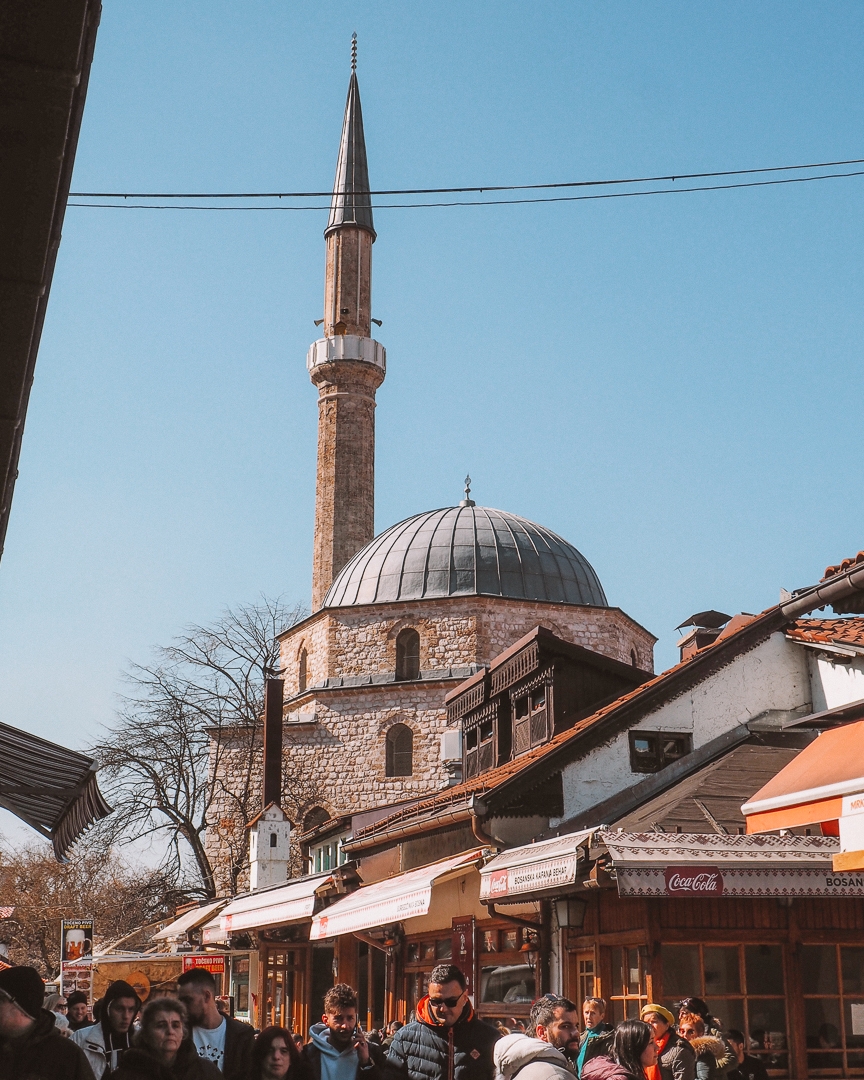
Vijećnica: Das Rathaus von Sarajevo
Erbaut wurde das Rathaus Vijećnica während der Regierungszeit von Österreich-Ungarn im sogenannten pseudo-maurischen Stil. Eine Bauart, die du nirgendwo anders als in Sarajevo finden wirst, wo die Österreicher versuchten, neue Gebäude stimmig ins Stadtbild einzufügen. Während des Bosnienkriegs brannte das Rathaus, das damals als Nationalbibliothek diente, komplett nieder und Millionen Bücher und Manuskripte fielen den Flammen zum Opfer. Heute ist das Gebäude wieder ein Rathaus und kann auch besichtigt werden (was ich dir unbedingt empfehle!).
Die Lateinerbrücke: Wo Weltgeschichte geschrieben wurde
Das Attentat auf Erzherzog Franz Ferdinand fand hier statt. Als der Thronfolger mit seinem Auto an einer Straßenecke festsaß, nachdem der Fahrer falsch abgebogen war, tötete Gavrilo Princip ihn und seine Ehefrau Sophie mit nur zwei Schüssen. Obwohl der Ort heute recht gewöhnlich aussieht, ist es beeindruckend zu denken: Hier wurde Weltgeschichte geschrieben!
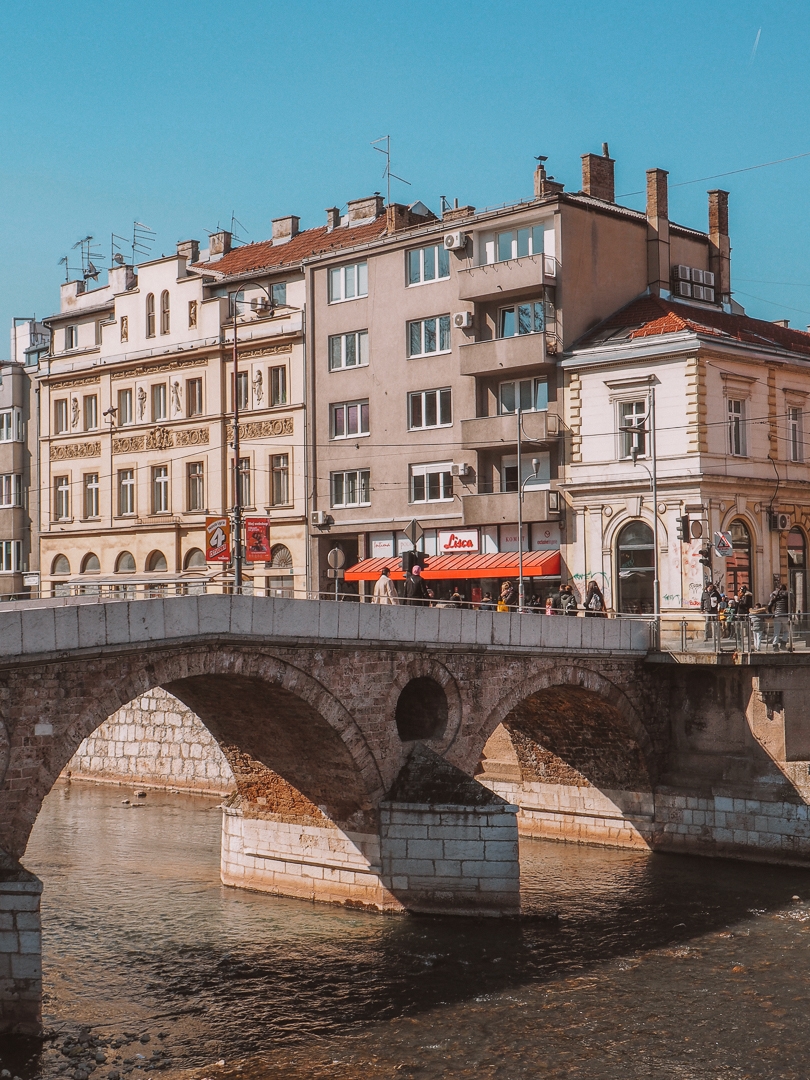
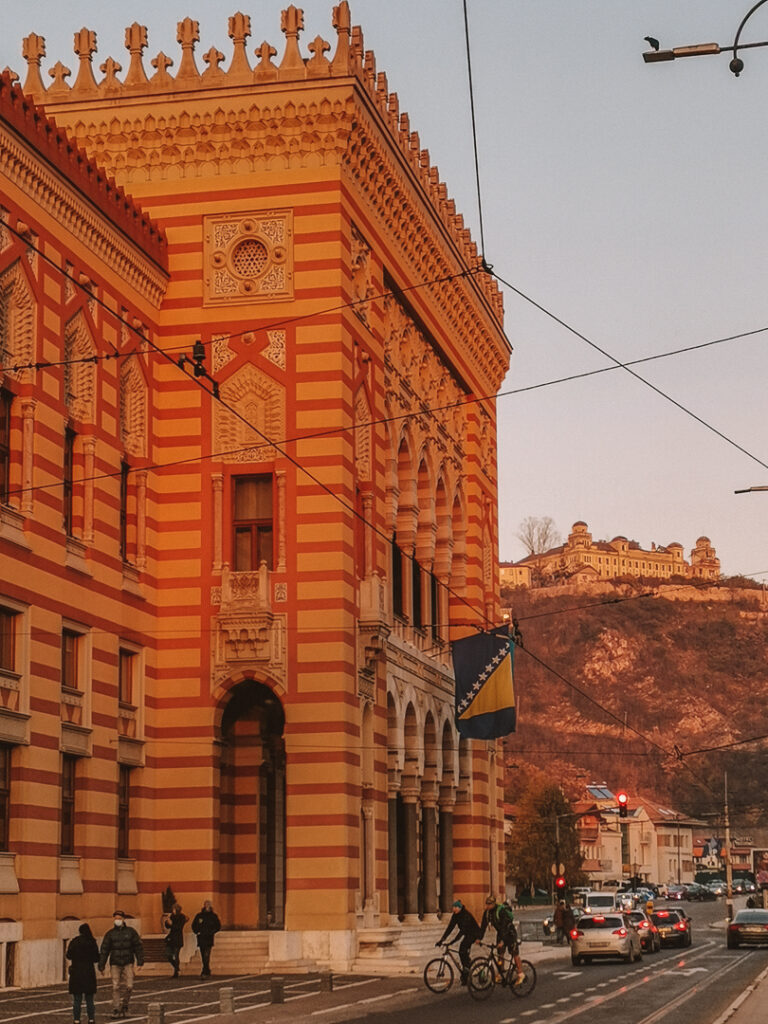
Sebilj Brunnen
Das Wahrzeichen in der Altstadt von Sarajevo ist ein alter osmanischer Brunnen. Gab es früher Hunderte davon in der ganzen Stadt, so ist heute nur der Seblij Brunnen geblieben. Um den rankt sich übrigens die Legende, dass wer einmal Wasser von Baščaršija trinkt, immer wieder nach Sarajevo zurückkehrt.
Vom Hauptplatz mit dem Sebilj zweigt die Kupferschmiedgasse ab – hier ist das traditionelle Schmiedehandwerk noch erhalten und du kannst die Handwerker bei ihrer Arbeit beobachten. Ein Muss!
Rosen von Sarajevo
Rund 200 findest du überallin der Stadt verteilt – die Rosen von Sarajevo wurden überall dort geschaffen, wo während der 1.425 Tage langen Belagerung der Stadt mehr als drei Menschen ums Leben kamen. Als Zeugen der Zeit begleiten sie dich also auf deiner Reise durch die Stadt und erinnern als stumme Mahnmale daran, dass wir aus der Geschichte lernen und zukünftiges Menschenleiden verhindern sollten.
Geheimtipp: Die Kaffeekultur ist in Bosnien und Herzegowina regelrecht das Rückgrat der Gesellschaft. Geh also unbedingt einen bosnischen Kaffee trinken, wenn du auf Baščaršija bist. Noch tiefer in die bosnische Kultur eintauchen kannst du mit einer city tour, die auch die Kaffeezeremonie inkludiert.
Eine Tour mit der Straßenbahn
Und eine kleine Extra-Sehenswürdigkeit: Mach doch eine Fahrt mit der ersten elektrifizierten Straßenbahn Europas. Die wurde nämlich hier in Sarajevo noch vor Wien installiert und in Betrieb genommen. Ein Ticket kostet (Stand 2024) nur 1,80 BAM und gibt es an jedem Kiosk zu kaufen.
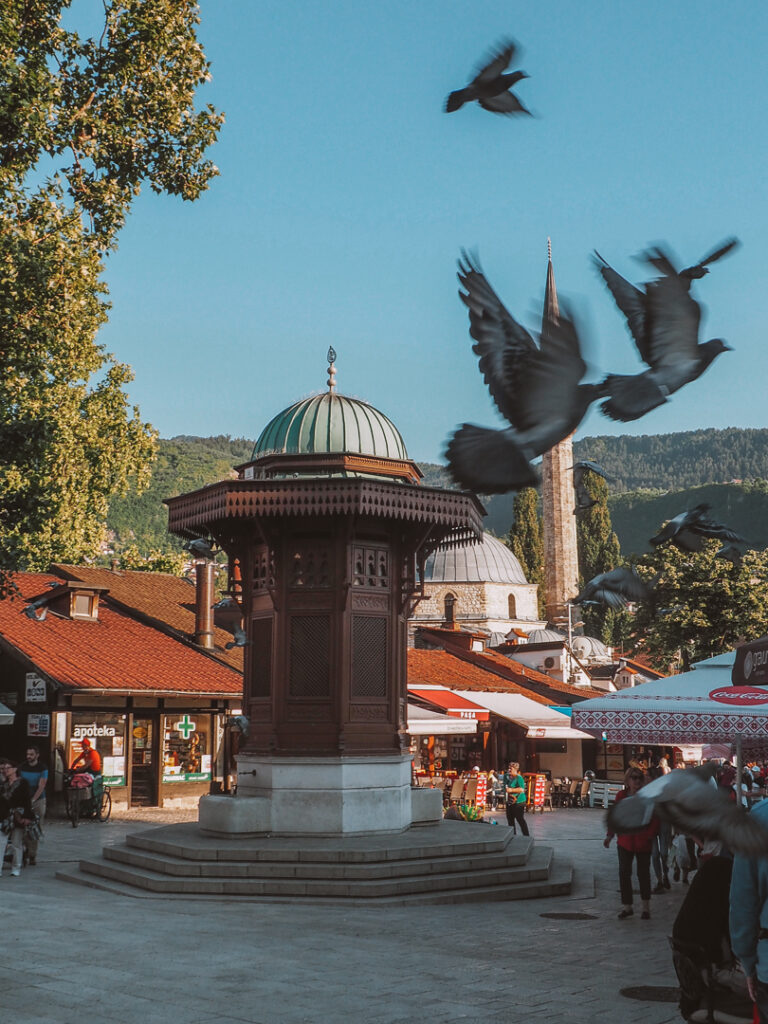
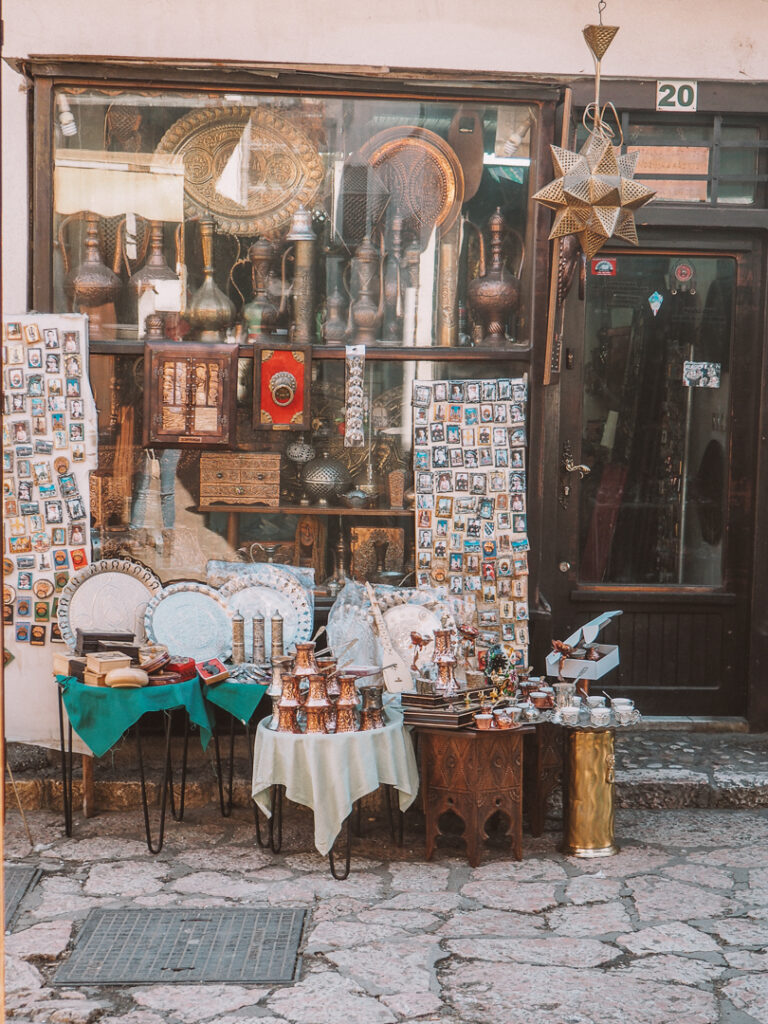
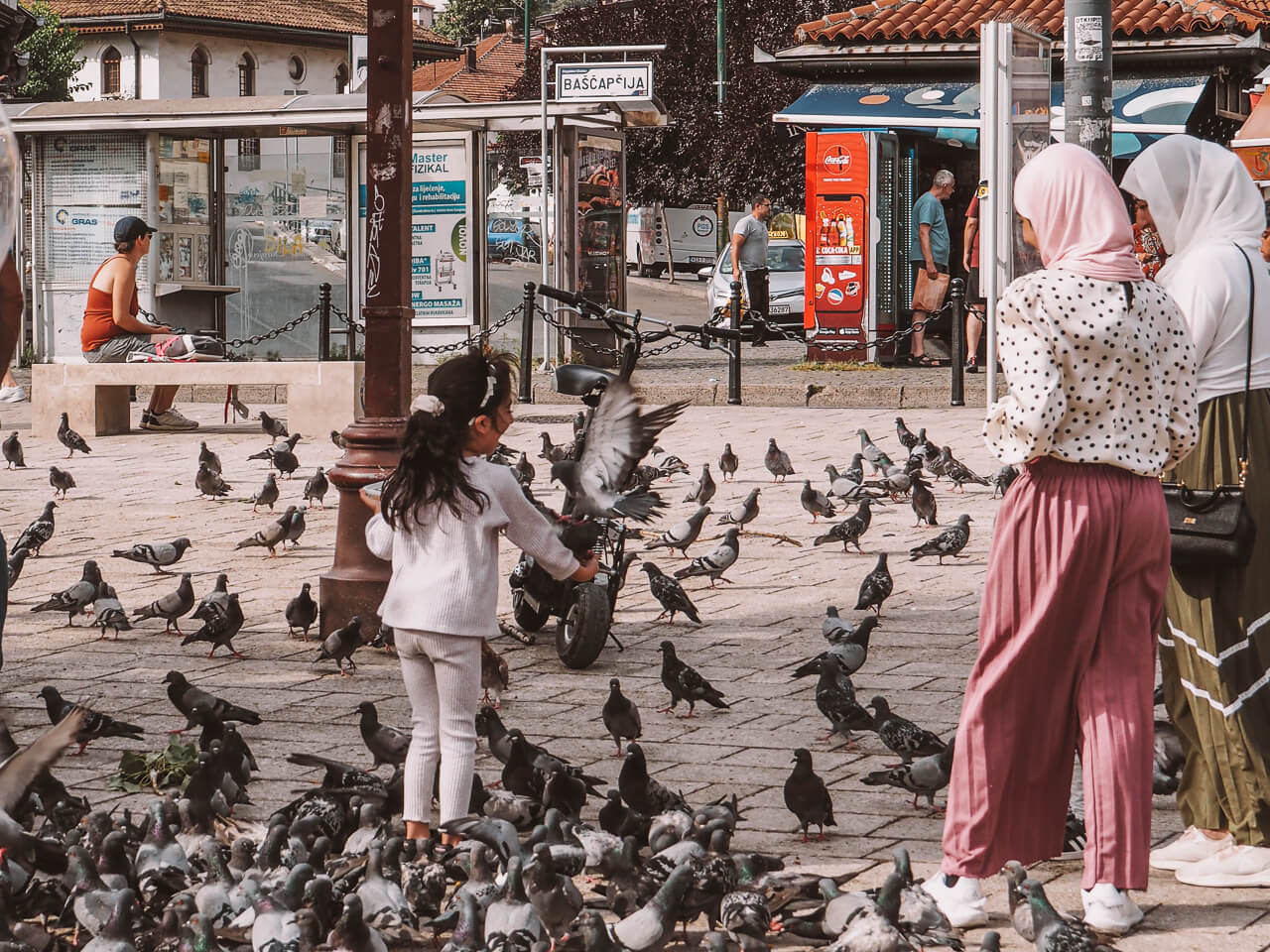
Religiöse Stätten von „Klein Jerusalem“
Das Jerusalem Europas wird Sarajevo auch genannt – wegen seiner religiösen Vielfalt. Im Umkreis von nur 200 Metern findest du hier eine Moschee, katholische Kathedrale, Synagoge und orthodoxe Kirche – dies gibt es nicht an vielen anderen Orten der Welt. Und auch heute noch feiert die Stadt ihre religiöse Vielfalt
Gazi Husrev-beg Moschee
Das zentral in der Altstadt gelegene Gotteshaus ist die einer der wichtigsten Moscheen des Landes und kann auch von Nicht-Gläubigen besucht werden. Besonders schön: Ihr geräumiger Innenhof mit dem wunderschön geschnitzten Baldachin über dem Brunnen und dem Blick auf Sahat Kula, den letzten Uhrturm der Welt, der noch die Mondzeit anzeigt. 3 BAM kostet der Eintritt. Betreten werden kann die Moschee ganztägig, außer zu Gebetszeiten und für Frauen werden Tücher bereitgestellt.
Kathedrale des Heiligen Herzens Jesu
Erst zur Zeit Österreich-Ungarns wurde diese katholische Kathedrale erbaut, die seitdem für die Einwohner von Sarajevo der Haupttreffpunkt geworden ist. „Lass uns an der Kathedrale treffen“, heißt es, wenn man sich verabredet. Innen wirkt die Kathedrale hell, fast luftig und ist somit ein spannender Kontrast zu gotischen Gotteshäusern in Westeuropa.
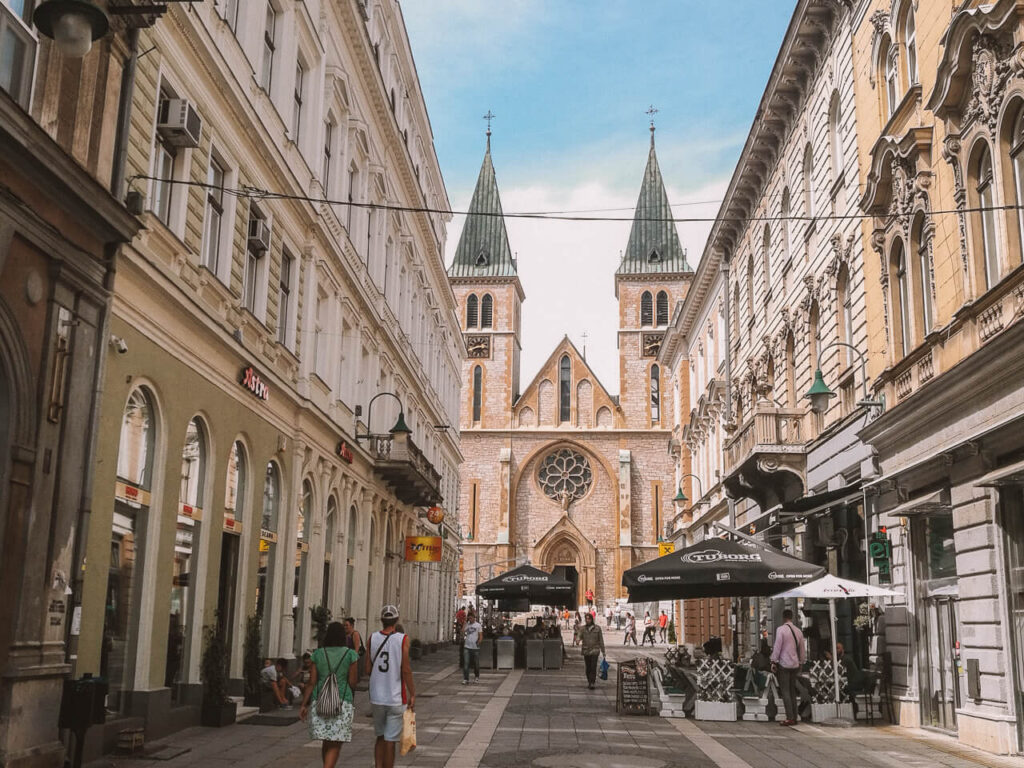
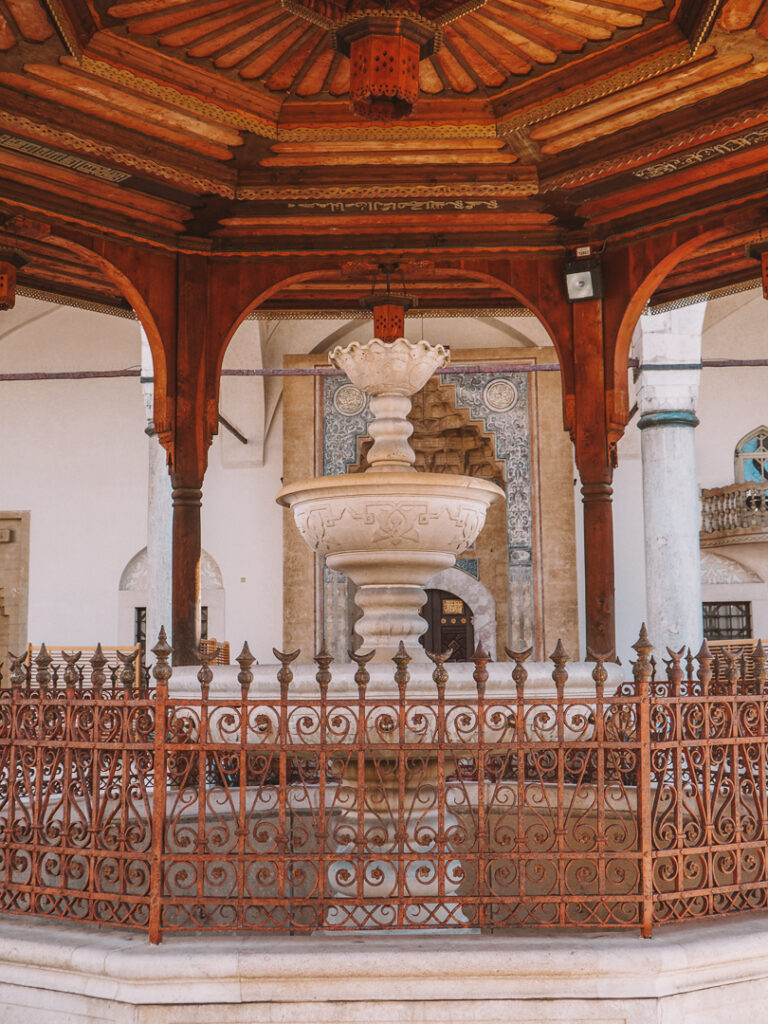
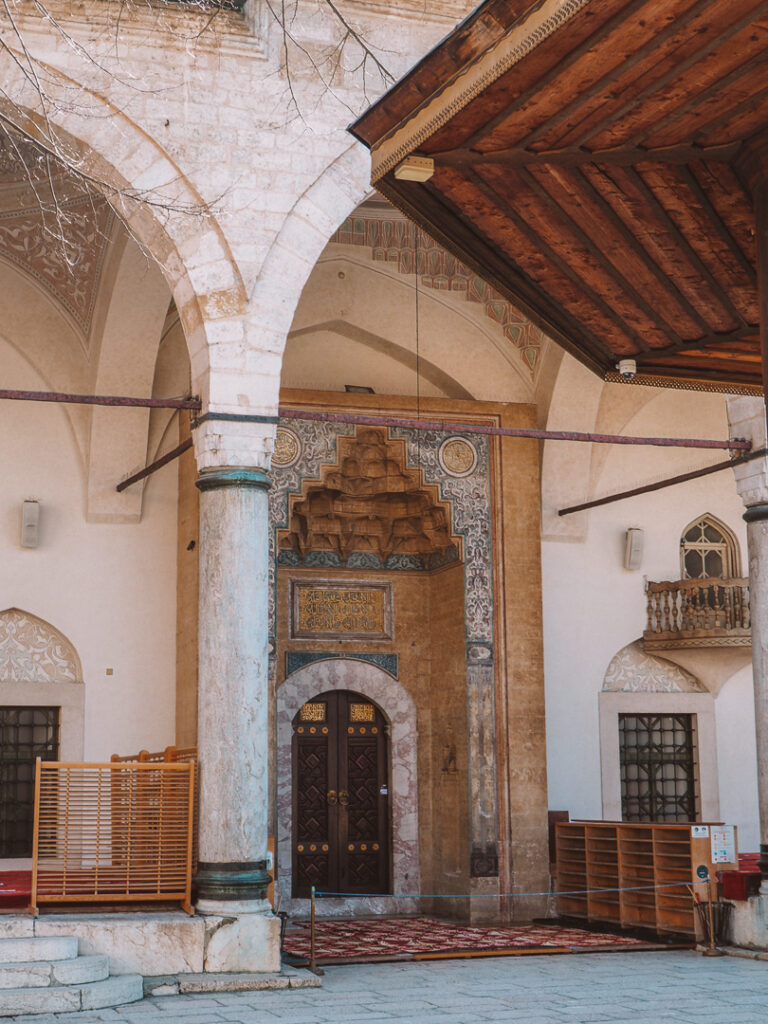
Mariä-Geburt-Kathedrale & alte orthodoxe Kirche
Nur eine Straßenecke von der Herz-Jesu-Kathedrale befindet sich die orthodoxe Kathedrale aus dem 19. Jahrhundert. Sie verdankt ihren Bau der Gleichstellung von Muslimen und Christen zur Zeit des osmanischen Reichs, die allerdings nicht ganz freiwillig geschah.
Für mich fast noch sehenswerter ist die „alte orthodoxe Kirche“ – ein Gotteshaus aus dem 16. Jahrhundert, dessen Fundamente aber sogar bis ins 5. Jahrhundert zurückreichen. Im dazugehörigen Museum können wertvolle Ikonen aus allen Jahrhunderten besichtigt werden. Der Eintritt kostet 2 BAM.
Alter Jüdischer Friedhof und Synagogen
20 Prozent der Bevölkerung Sarajevos waren bis zum 2. Weltkrieg jüdischen Glaubens. Heute spiegelt sich das im Stadtbild leider nicht mehr viel wider. Dennoch kannst du das jüdische Viertel Mejtaš, sowie auch den alten jüdischen Friedhof (der zweitgrößte in Europa nach Prag!) auch heute noch erkunden und alte jüdische Häuser und Synagogen dort entdecken.
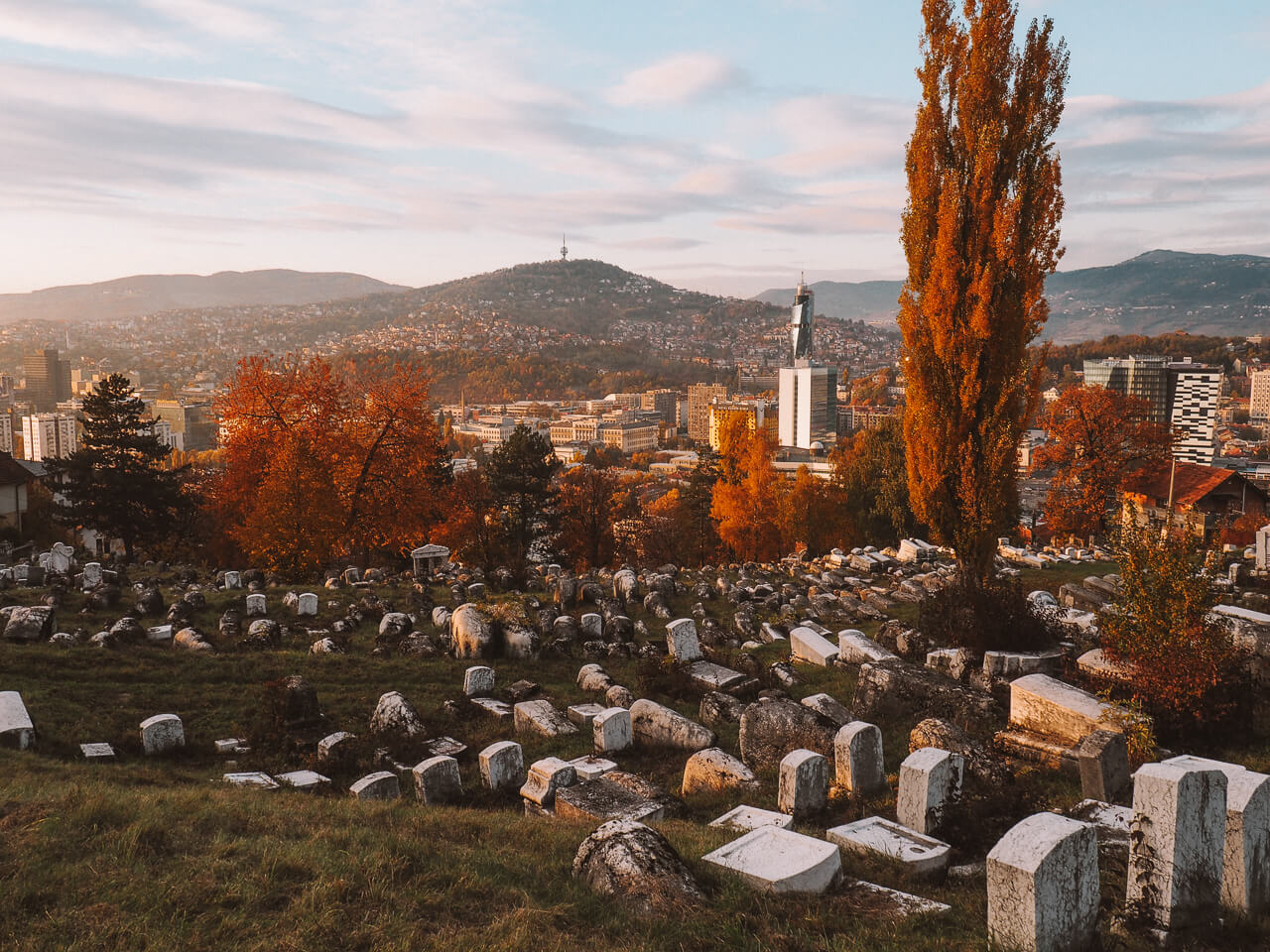
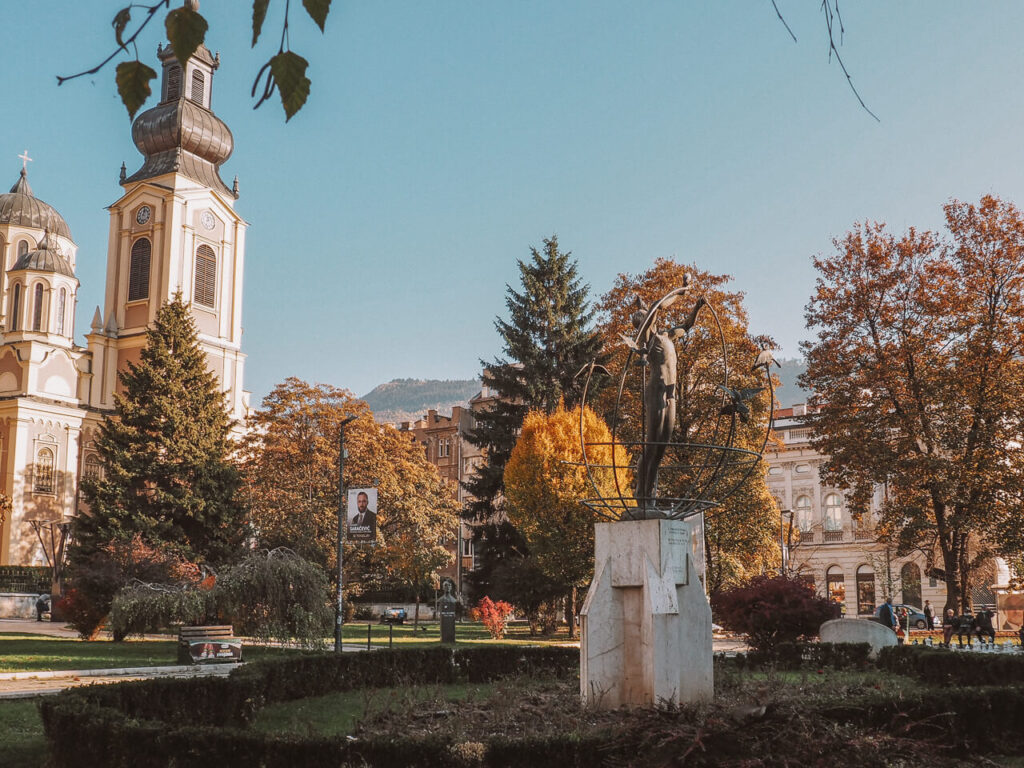
Mehr Tipps und Sehenswürdigkeiten in Sarajevo gesucht?
Ich lebe seit 2021 in Bosnien und Herzegowina und kenne das Land und ganz besonders seine Hauptstadt Sarajevo inzwischen in- und auswendig.
Für jeden, der Sarajevo zum ersten Mal erkundet, habe ich einen Reiseplan zusammen gestellt, der alle Sehenswürdigkeiten und einige Geheimtipps beinhaltet.
Die besten Aussichtspunkte von Sarajevo
Die besten Aussichtspunkte in Sarajevo? Die gelbe und die weiße Bastion. Letztere ist leider nur bis 17.00 Uhr geöffnet, das schönste Stadtpanorama hast du also zum Sonnenuntergang von der gelben Bastion. Der Blick geht durchs ganze Miljacka-Tal und auf die ganze Stadt. Während Ramadan ist die Atmosphäre auf der Zuta Tabija besonders stimmungsvoll: dann wird täglich zu Sonnenuntergang ein Kanonenschuss abgefeuert und die Menschen brechen gemeinsam das Fasten.
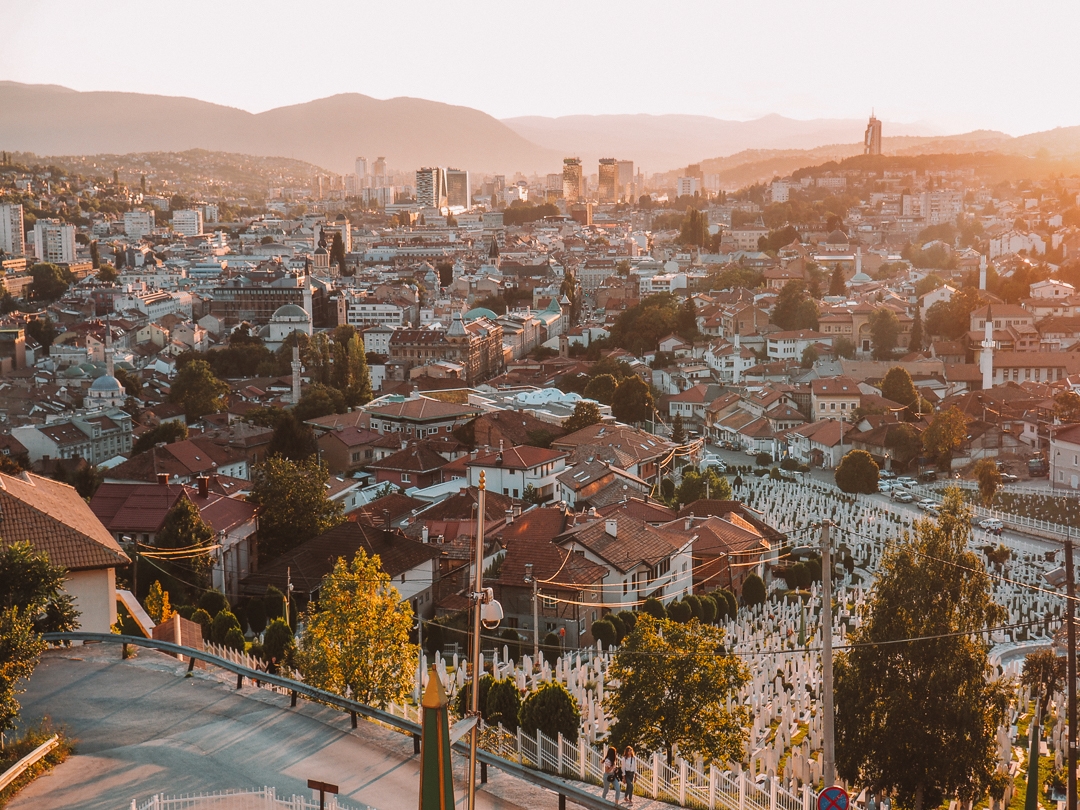
Kulturelle Sehenswürdigkeiten in Sarajevo
In einer Stadt mit einer solch reichen Geschichte hast du vermutlich auch nach einer Stadtführung noch ein paar offene Fragen und willst mehr zur Kultur und den Hintergründen erfahren. Hier sind einige Museen und Kunstgalerien, die ich empfehlen kann:
Museen
Sarajevo Tunnel: Im Tunnelmuseum kannst du sehen, wie die Menschen sich während der Belagerung durch einen Tunnel mit Medikamenten und Lebensmitteln versorgt haben
War Childhood Museum: Dieses preisgekrönte Museum stellt Exponante aus der Kindheit von Kriegskindern aus, nicht nur aus Bosnien, sondern auch aus Syrien oder der Ukraine
Nationalmuseum von Bosnien und Herzegowina: An jedem ersten Samstag im Monat kannst du hier die wertvolle jüdische Haggadah bewundern
Olympisches Museum: Exponante und Filme von den olympischen Winterspielen 1984 werden in diesem Multimedia-Museum ausgestellt
Svrzo Haus und Despić Haus: Die beiden orginalgetreu erhaltenen Häuser zeigen dir, wie wohlhabende muslimische und orthodoxe bosnische Familien früher lebten
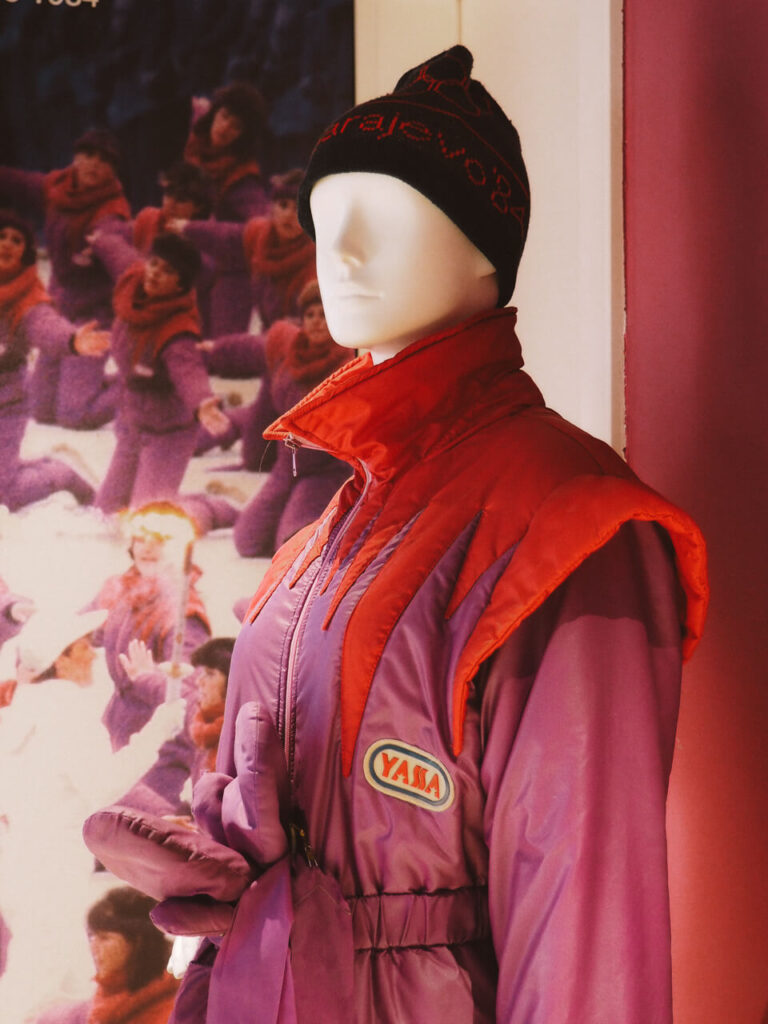
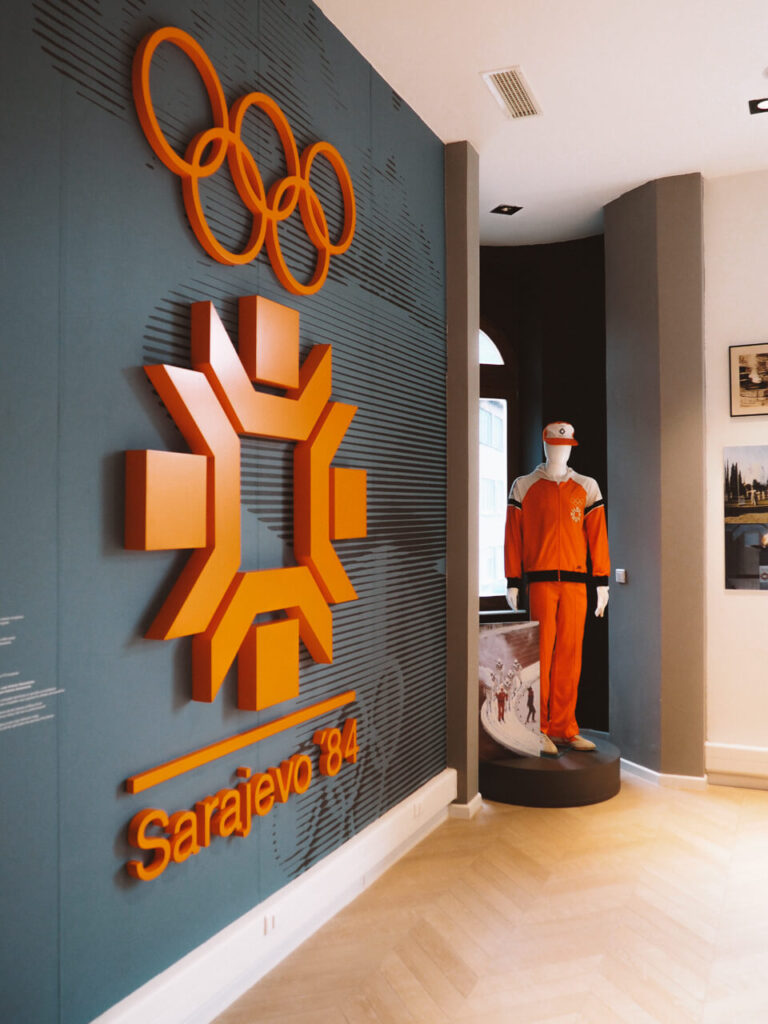
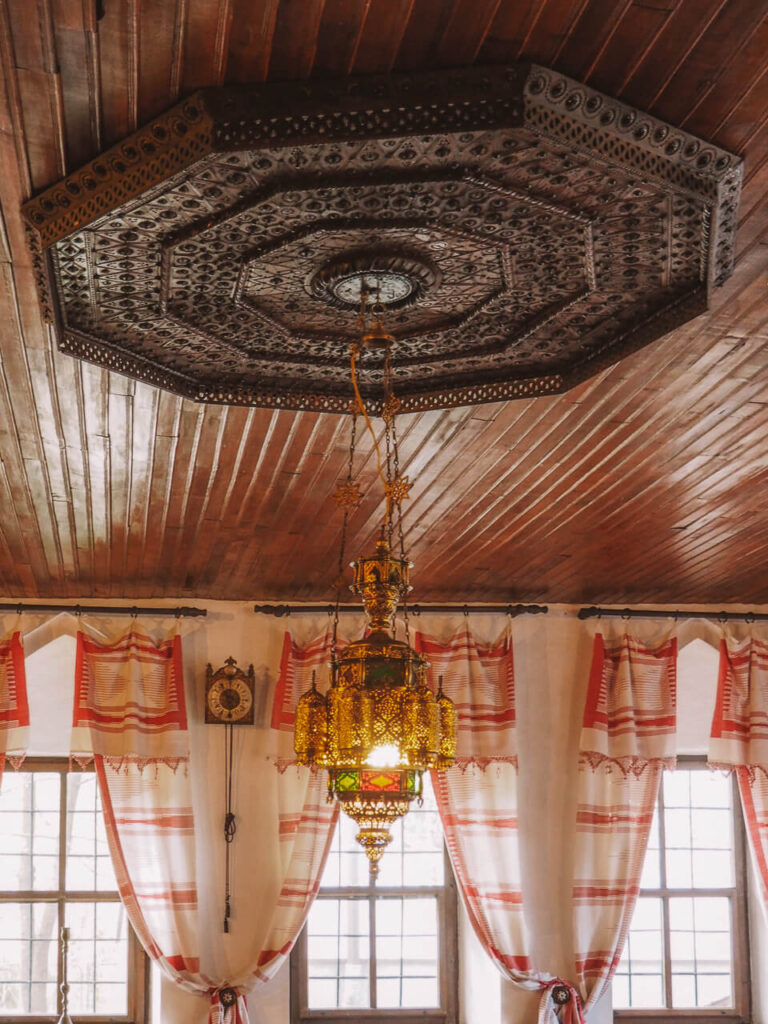
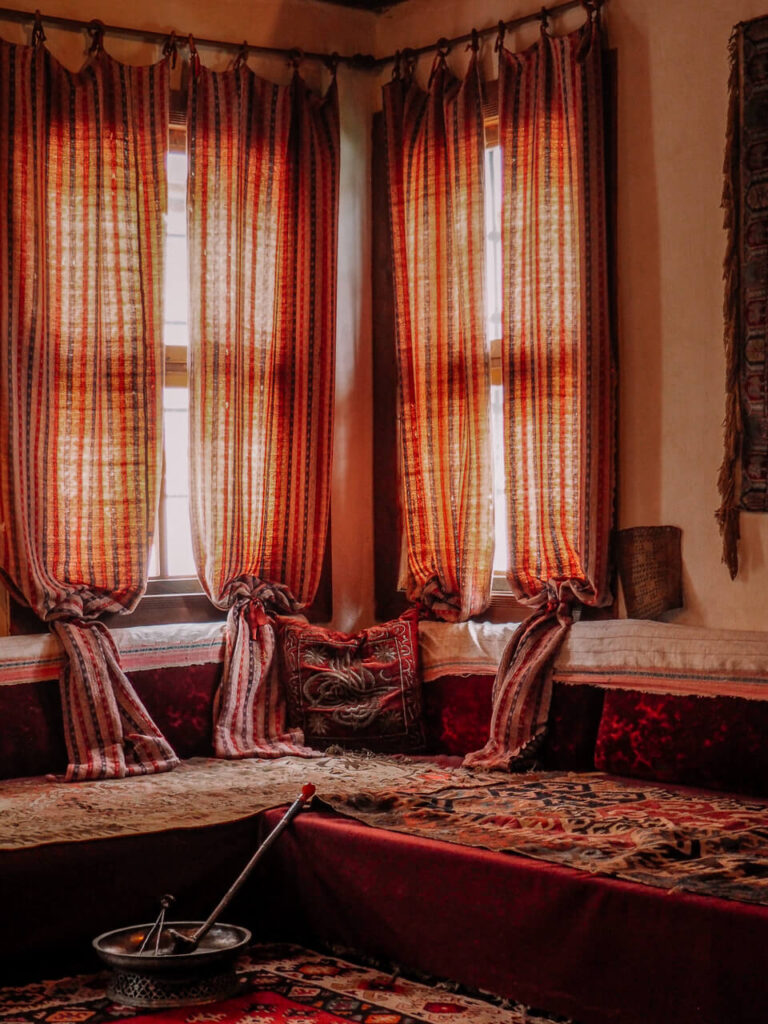
(Kunst)Galerien
Manifesto: Galerie für contemporary art, die jungen Künstler eine Bühne gibt
Europe Haus: Wechselnde Ausstellungen, von Fotografie bis hin zu Malerei
Collegium Artisticum: Galerie für zeitgenössische Kunst. Gegründet in den 70er Jahren überdauerte sie auch die Belagerung von Sarajevo und gibt nun alternativen Künstlern eine Bühne
Kulturelle Veranstaltungen und Festivals
Einige diseser kulturellen Veranstaltungen wirst du in keinem Reiseführer finden! Aber da ich seit 2021 in Sarajveo lebe, weiß ich, welche Festivals wann stattfinden und auf welchen du die schönten Erlebnisse mit Locals haben und die Begeisterung über ihre Stadt teilen kannst.
Sarajevo Film Festival
Das Sarajeo Film Festival, kurz SFF, ist das bedeutenste Filmfestival Südeuropas. Gestartet wurde es 1995 während der Belagerung Sarajevos und findet seitdem jährlich für acht Tage im August statt. Regionale und internationale Filme werden gezeigt, Prominente spazieren über den roten Teppich und die gesamte Stadt steht Kopf – mit zahlreichen Parties, Panels und Veranstaltungen. Das jeweils aktuelle Datum findest du auf sff.ba.
Garden of Dreams
Seit einigen Jahren mischt das Festival und bosnische Record Label die Musikszene der Hauptstadt auf – an den coolsten Locations von Sarajevo legen den ganzen Sommer über für Tagesfestivals weltbekannte DJs wie Kollektiv Turmstraße oder Hot Since 82 auf und jeden Frühsommer findet ein mehrtägiges Festival statt. Aktuelle Veranstaltungen findet du stets auf Instagram.
Bascarsija Nights & Kultur na Ulice
Ebenfalls den gesamten Sommer über finden von der Stadt organisierte kostenlose Kunst- und Kulturveranstaltungen in der Altstadt statt – von Ballett über Oper unterm Sternenhimmel ist alles dabei. Kultur wird so allen Menschen zugänglich gemacht und beim milden Sommerwetter versammeln sich jung und alt um den Veranstaltungen beizuwohnen.
Die einen Monat andauernden Baščaršija Nights werden meisten here veröffentlicht (meist Juni oder Juli), „Kultur auf der Straße“ postet auf Instagram aktuelle Veranstaltungen (meist Mai – Septemver).
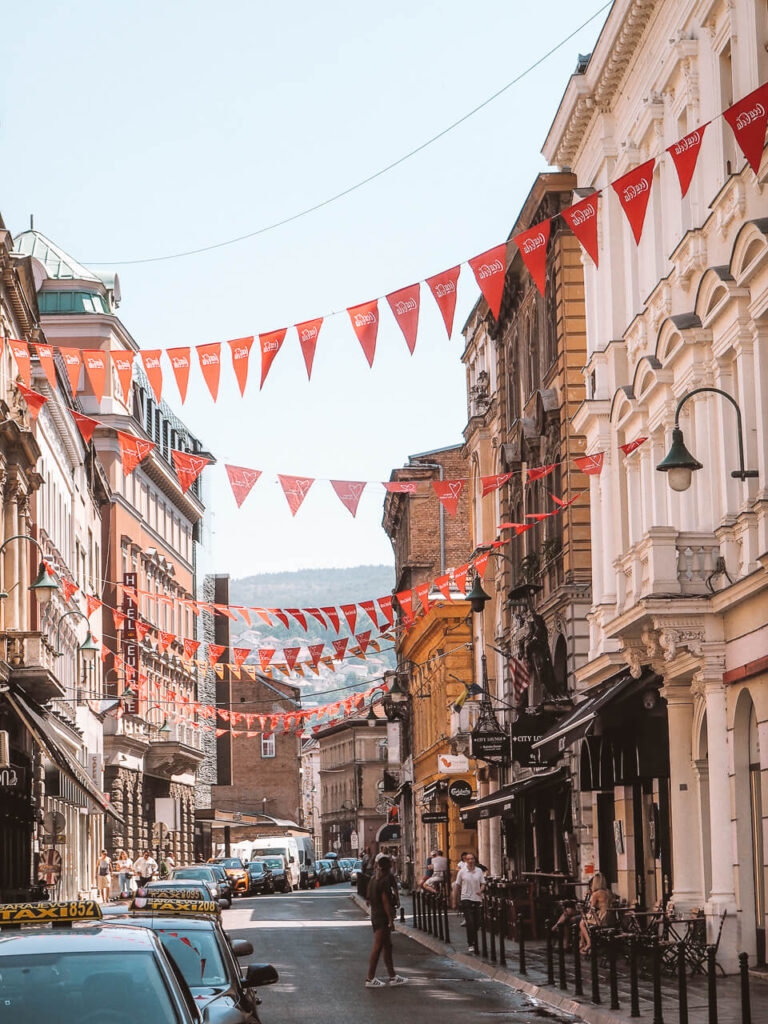
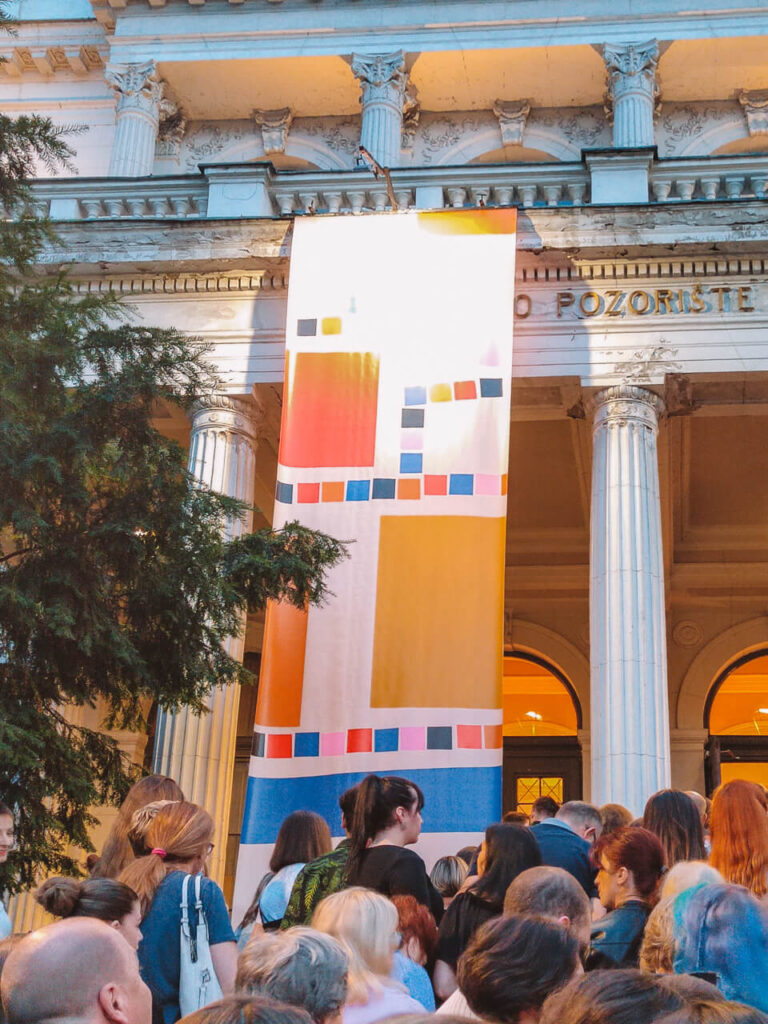
Raus ins Grüne: Sehenswürdigkeiten in Sarajevo mitten in der Natur
Hausberg Trebević
Nicht viele Städte auf der Welt haben einen Berg direkt vor der Haustür. Sarajevo schon – und das macht es natürlich zu einem Muss, mit der im Jahr 2018 wieder eröffneten Seilbahn auf den Hausberg der Stadt zu gondeln.
Von der Seilbahnstation sind es nur wenige Gehminuten bis zum Start der Olympia Bob- und Rodelbahn Trebević – einem Lost Place, der heute voller Murals und Graffitis ist und den man entlang spazieren kann. Mehr Infos findest du in diesem Beitrag.
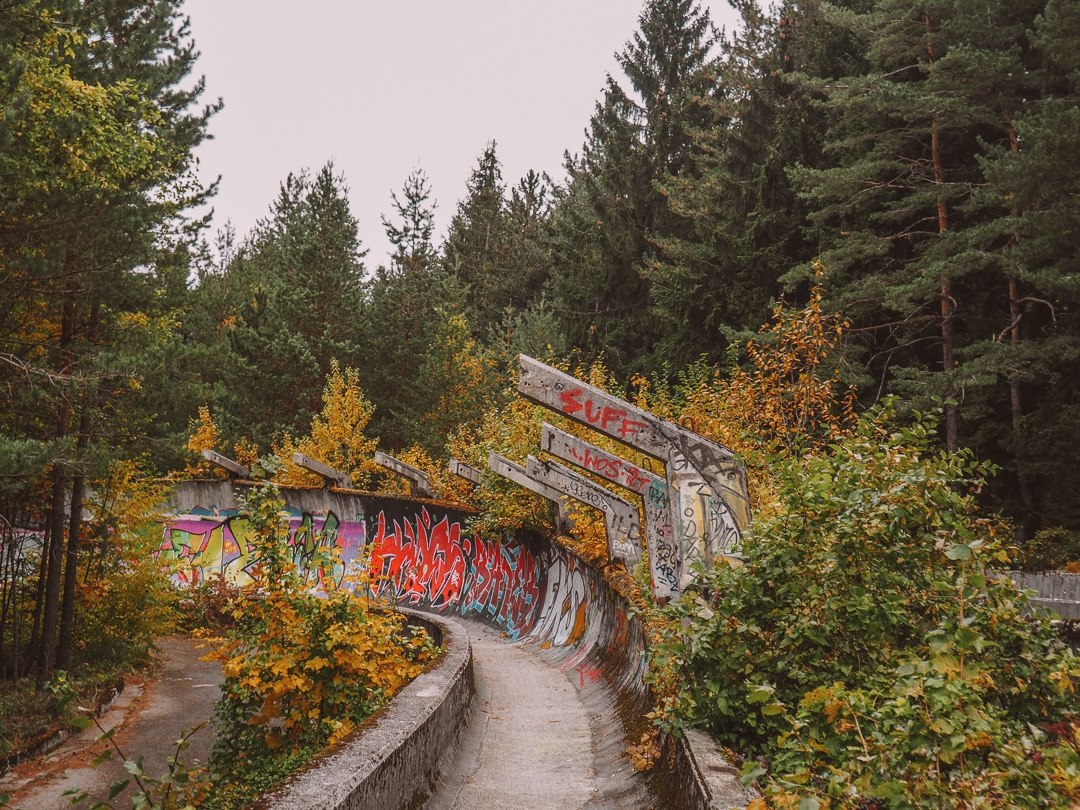
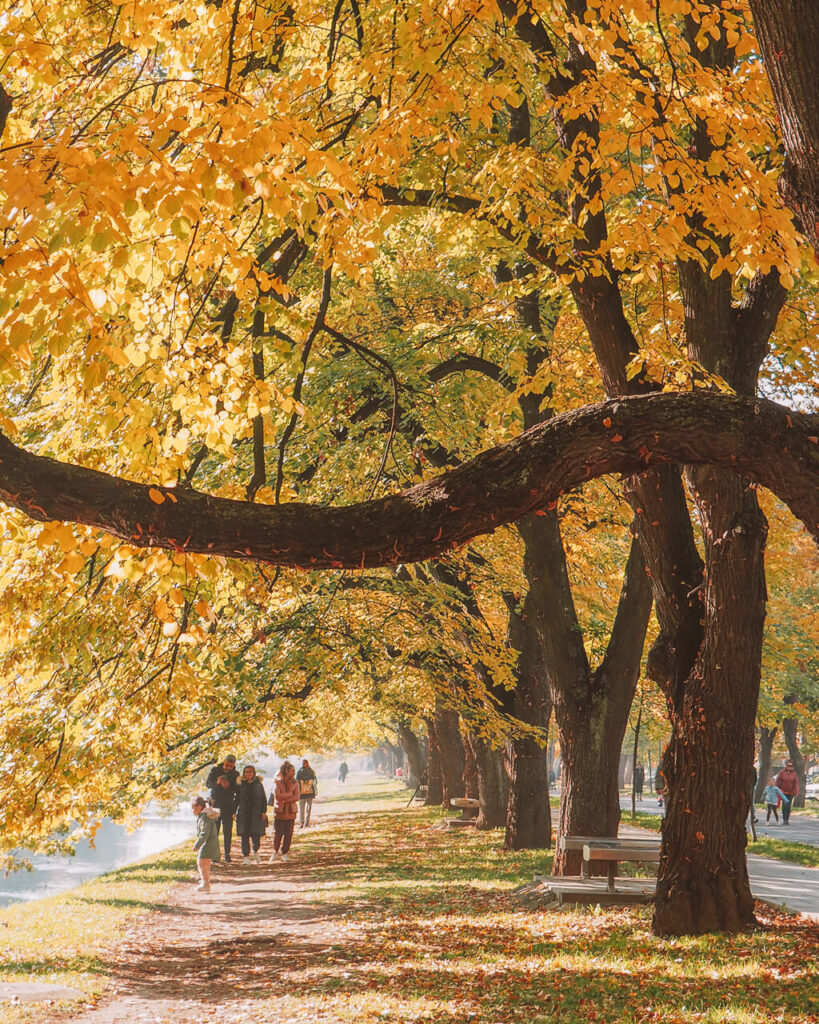
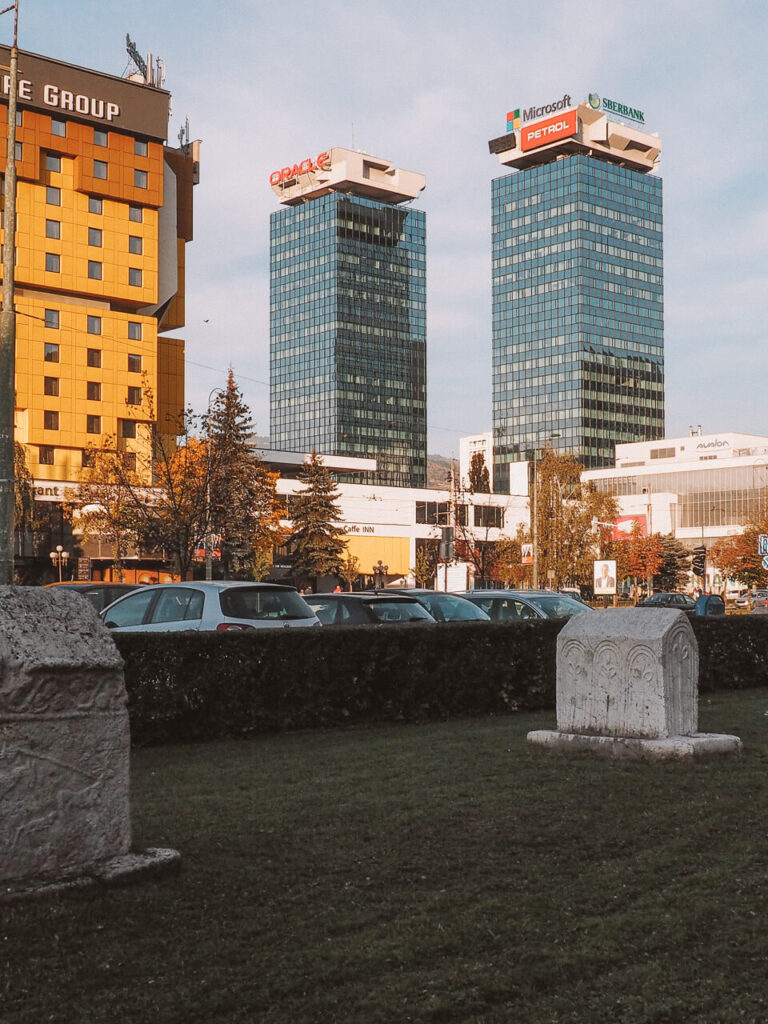
Miljacka Flusspromenade
Jeden Abend ab 17.00 Uhr wird sie für den Verkehr gesperrt: Vilsonov Šetalište, einer meiner Geheimtipps. Am frühen Abend findest du hier Einheimische Sport treiben, ihre Hunde ausführen, mit Kindern spazieren gehen oder einfach nur die Zeit unter den großen Linden am Flussufer genießen. Hier kannnst du dich wirklich unter die Einwohner Sarajevos mischen und die Atmosphäre der Stadt aufsaugen. Danach setzt du dich einfach in eines der zahlreichen Restaurants in der Promenade.
Vrelo Bosne
Das Vrelo Bosne Landschaftsschutzgebiet im Stadtteil Ilidza ist ein wunderschöner Park aus den mäandernden, sich verästelnden Flüsschen, die von ihrer Quelle zum Fluss Bosna zusammenfließen, der dem Land seinen Namen gab. Dieser Park ist perfekt für Familien mit Kindern – zum picknicken oder entspannen vom Stadtleben.
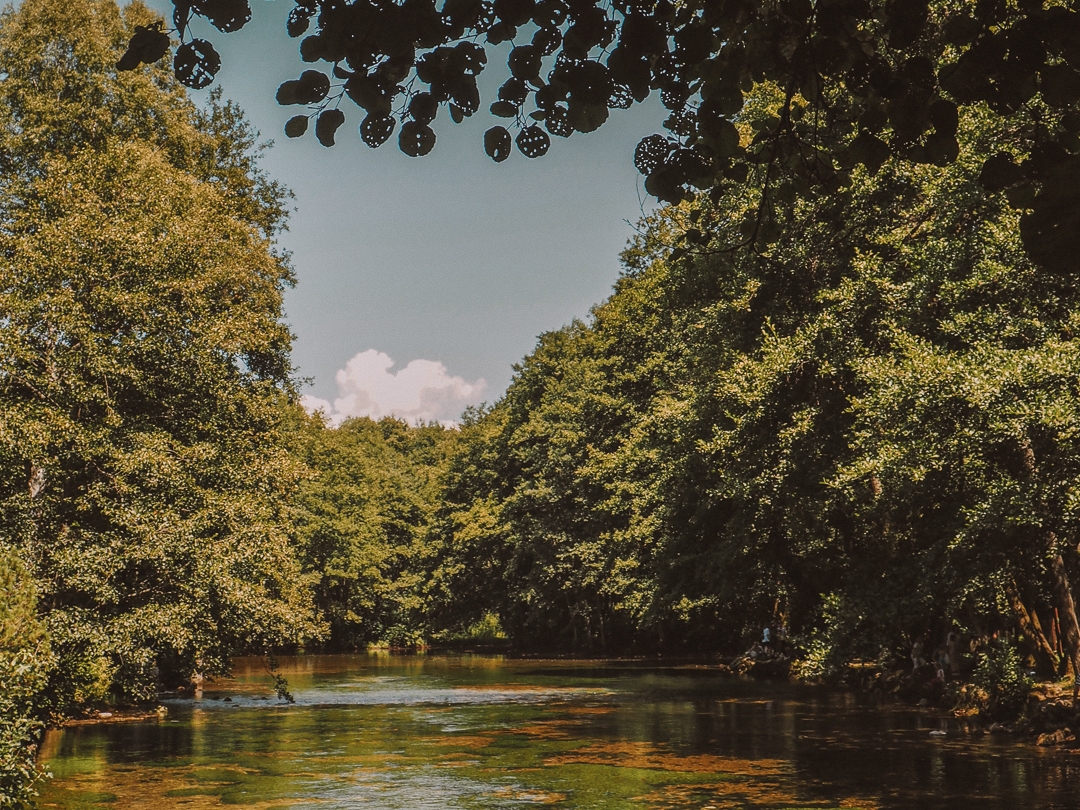
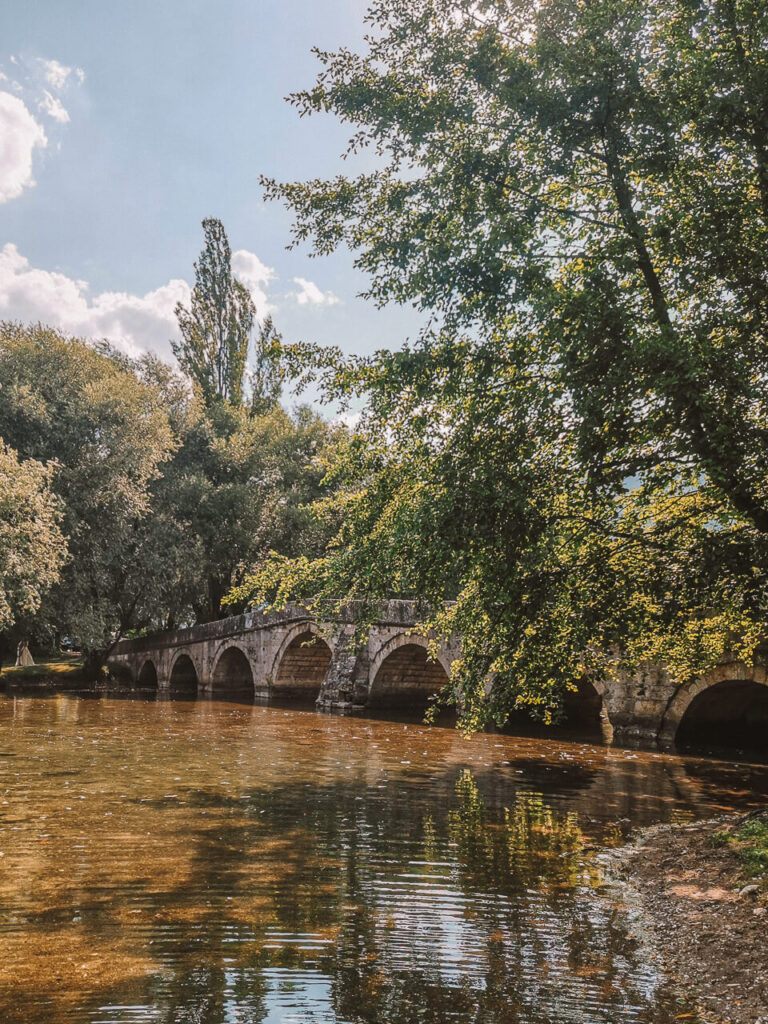
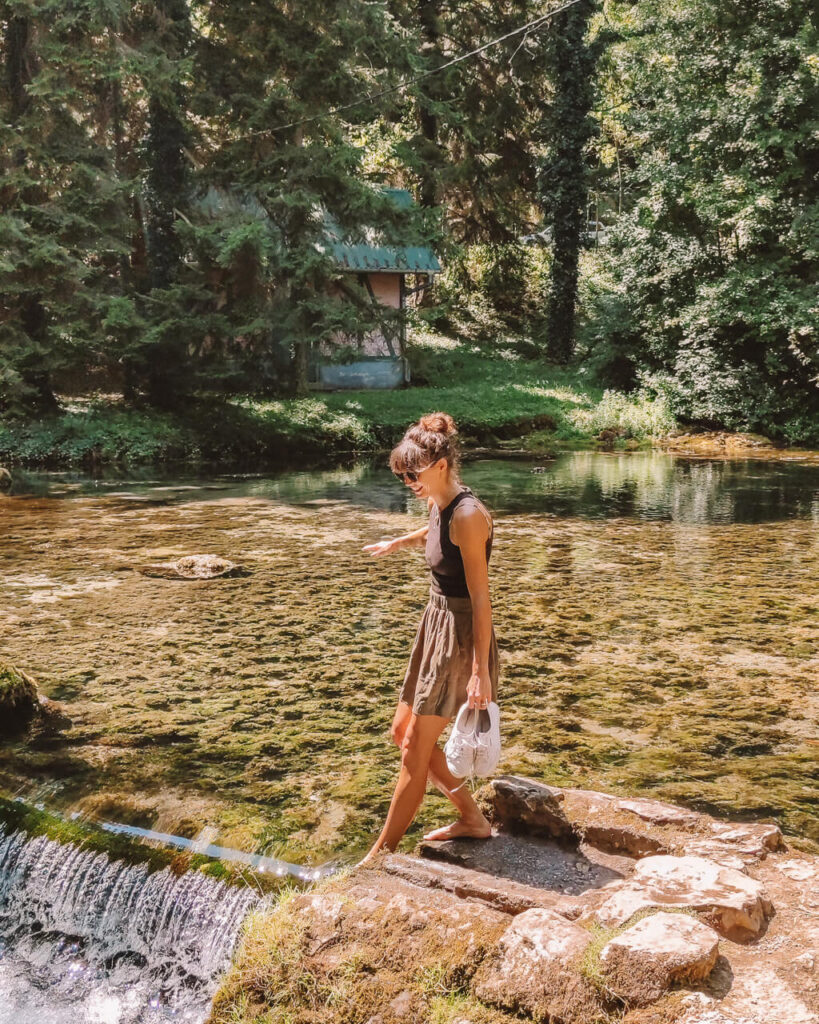
Tagesausflüge von Sarajevo
Naturpark Skakavac – Sarajevos spektakulärer Wasserfall
Sarajevo ist von wilder Natur umgeben – das gibt Reisenden die Möglihckeit, Stadtleben, Architektur ud Geschichte mit Aktivitäten wie Wandern oder Mountainbiken zu verbinden. Rund 20 Minuten sind es vom Stadtzentrum zum Startpunkt der Wanderung zum Skakavac-Wasserfalls, der sich 98 Meter in die Tiefe ergießt. Ein beeindruckender Anblick. Am besten erkundet du den Naturpark mit einem lokalen Guide.
Sarajevo Ausflugsziele: das zauberhafte Mostar
Eine Fahrt von Sarajevo nach Mostar mit dem Zug unternehmen – das steht auf der Bucketliste vieler Besucher. Am besten ist es, in Mostar eine Übernachtung einzuplanen, denn es gibt viel zu sehen. Nicht nur die UNESCO-geschützte Altstadt mit ihrer alten Brücke, sondern auch rund um die größte Stadt der Herzegowina. Wenn du aber nur einen Tag zur Verfügung hast, kannst du morgens mit dem Zug hinfahren und abends wieder zurück. Mehr Ideen für Mostar findest du hier.

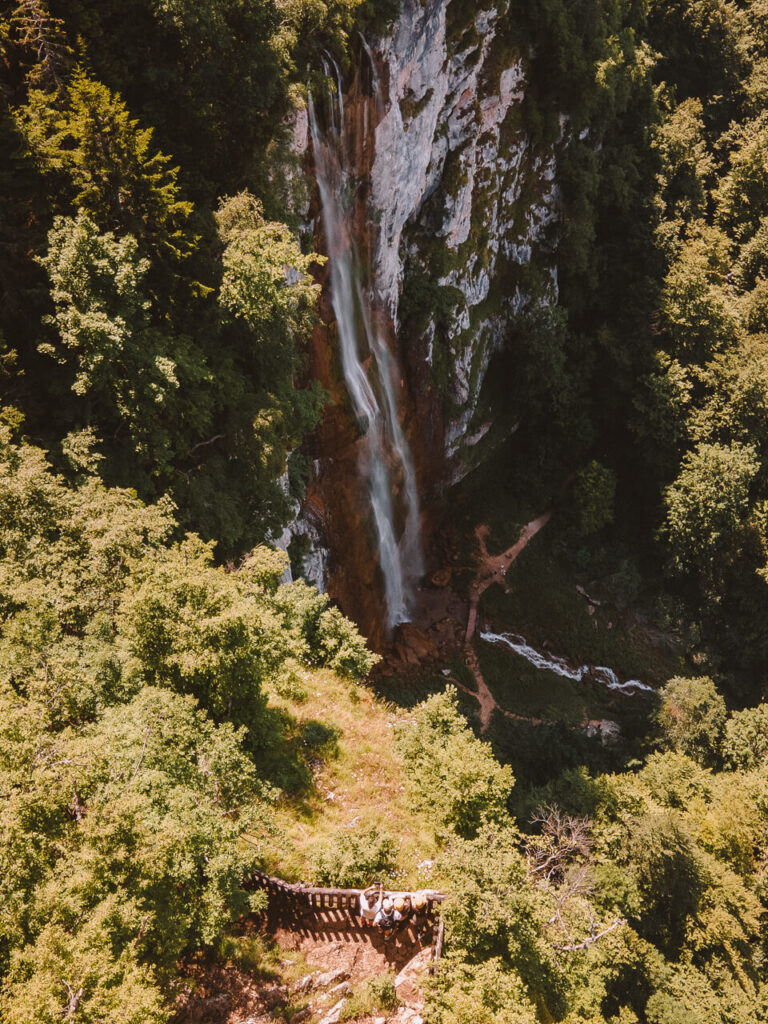
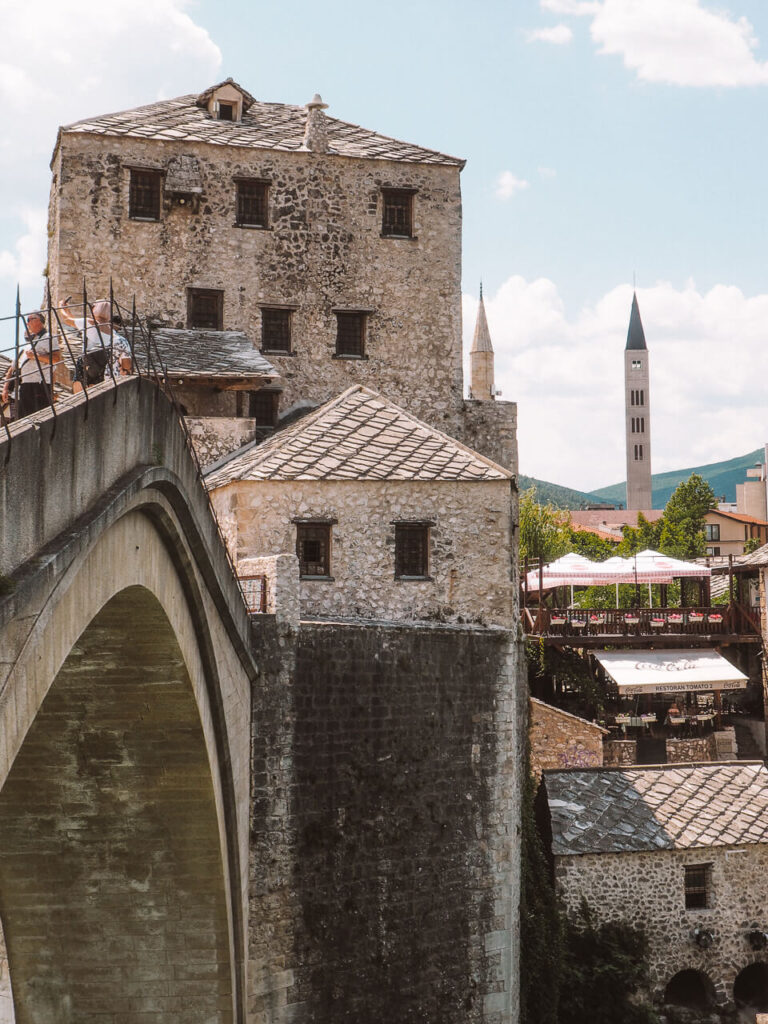
Diese Beiträge zu Sarajevo könnten dich auch interessieren:
Travel planning for Bosnia-Herzegovina made easy
💸 What is the currency of Bosnia and Herzegovina?
In Bosnia and Herzegovina, the convertible mark (KM for short) is used for payment. It has been the currency of Bosnia and Herzegovina since 22 June 1998 and was pegged to the German mark at a ratio of 1:1 until 2001 and to the euro since 2002. One euro is always exactly 1.95583 KM). The conversion is therefore very simple.
🇧🇦 What language is spoken in Bosnia and Herzegovina?
The official languages of the country are Bosnian, Serbian and Croatian, but there are hardly any linguistic differences between them - I always compare them to German and Austrian. Serbian, however, uses Cyrillic letters, which can lead to confusion in the Republika Srpska part of the country. The best thing to do is to download Google Translate, which also allows you to take photos of Cyrillic menus or street signs and have them translated.
💉 Do I need international health insurance for Bosnia and Herzegovina?
Absolutely! You should never, never, never travel without international health insurance. Bosnia and Herzegovina is also not in the EU, which means that your German health insurance covers the country. not with. I am always happy to recommend other travellers SafetyWing. For less than one euro per day, you can insure yourself here and also protect yourself against the risks of extreme sports, lost luggage and other travelling ailments.
📲 Can I use European roaming in Bosnia and Herzegovina?
No, as Bosnia and Herzegovina is not in the EU, your roaming package does not apply here. You can either buy a SIM card locally at a kiosk for a few marks or simply get an eSIM like Airalo, which you can even use for other countries after your trip to Bosnia. You can download the Airalo app here.
🪂 Which tour operator is recommended for my trip to Bosnia?
Together with my Bosnian partner, I founded the boutique travel agency .Cheyf in 2022. We have combined our experience of sustainable tourism in places like South Africa with our knowledge of Bosnia and the way of life in Bosnia. ćejf united - savouring the little moments that make life worth living. This has resulted in tours that convey sustainability, local experiences and communities and a real attitude to life. Here you can take a look at our tours and get to know Cheyf better.
🗺️ I would like to travel without a travel agency, are there any ready-made routes?
Yes! I offer an interactive travel map for the whole of Bosnia and Herzegovina, with several ready-made itineraries and lots of restaurants and insider tips. And best of all, the map is regularly updated and expanded, meaning you always have the latest recommendations in your pocket. Click here for the interactive travel guide.
💦 Can I drink the tap water in Bosnia and Herzegovina?
You can drink the water in large cities without hesitation. Bottled water is recommended after heavy rainfall or flooding and in rural areas.
🛬 Where can I find the best flights to Bosnia and Herzegovina?
You can find the cheapest flights on Kiwi - where you can compare prices directly.
🏯 Where can I find the best accommodation in Bosnia and Herzegovina?
Most accommodation in Bosnia and Herzegovina, including private accommodation, is often offered at Booking.com set. In addition to hotels, you can also book flats or guesthouses here and directly support the Bosnian population with your stay.
🛵 Where can I book a hire car for my trip to Bosnia?
On Rentalcars.com you can choose from a wide range of hire cars and compare prices. I recommend that you always book with fully comprehensive insurance. The German driving licence is valid, so you don't need to pack an international driving licence.
This blog article contains personal recommendations in the form of affiliate links. If you book or buy something via the links, I will receive a small commission. This does not change the price for you at all. Thank you for your support.
